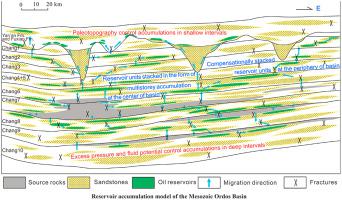当前位置:
X-MOL 学术
›
Mar. Petrol. Geol.
›
论文详情
Our official English website, www.x-mol.net, welcomes your feedback! (Note: you will need to create a separate account there.)
Controls on hydrocarbon accumulation by facies and fluid potential in large-scale lacustrine petroliferous basins in compressional settings: A case study of the Mesozoic Ordos Basin, China
Marine and Petroleum Geology ( IF 4.2 ) Pub Date : 2020-12-01 , DOI: 10.1016/j.marpetgeo.2020.104668 Hongjun Qu , Bo Yang , Shengli Gao , Junfeng Zhao , Xing Han , Shuo Chen , Khizar Hayat
Marine and Petroleum Geology ( IF 4.2 ) Pub Date : 2020-12-01 , DOI: 10.1016/j.marpetgeo.2020.104668 Hongjun Qu , Bo Yang , Shengli Gao , Junfeng Zhao , Xing Han , Shuo Chen , Khizar Hayat

|
Abstract Large-scale lacustrine basins in compressional settings are an important type of petroliferous basin, and the study of the characteristics of hydrocarbon accumulation in such basins is of great significance. This synthesis paper takes the Mesozoic Ordos Basin (central China) as a case study to establish lateral and vertical hydrocarbon accumulation patterns in this basin type, and highlights how facies and fluid potential control hydrocarbon accumulation in such basins. Based on systematic analyses of the Mesozoic source rocks, sedimentary facies, migration and accumulation patterns, and characteristics of the oil reservoirs, the hydrocarbon accumulation characteristics in the Mesozoic Ordos Basin are discussed. The analysis indicates that sedimentary facies controlled the characteristics and distribution of hydrocarbon source rocks and reservoirs, while diagenetic facies controlled the quality and distribution of the reservoirs. Excess pressure and fluid potential controlled hydrocarbon migration directions and paths, whereas facies and potential controlled the locations of oil accumulations and traps. It is concluded that source rocks controlled oil-bearing regions, sedimentary facies controlled oil-bearing plays, and fluid potential controlled the locations of accumulations. For shallow intervals, because fluid migration is mainly controlled by buoyancy, paleotopographic highs played an important role in controlling hydrocarbon accumulations. For deep layers (Chang 7 to Chang 10 members), since buoyancy is less than the capillary pressure, excess pressure caused by the undercompaction of mudstone and hydrocarbon generation at depth provides the driving force for lateral and vertical migration of oil, and becomes the main migration force. The reservoir accumulation characteristics differ laterally between regions of the basin; at the periphery of the basin, reservoir units are stacked in a step-wise manner, whereas at the center of the basin, multiple reservoir intervals are vertically stacked in the form of multistorey accumulations. Vertically, layers with different burial depths have different accumulation characteristics; the paleotopography controlled hydrocarbon accumulation in shallow intervals; instead excess pressure, fluid potential, and paleotopography controlled accumulation in deep intervals. This understanding could be used to inform prospecting in other large-scale lacustrine petroliferous basins in compressional settings such as the Eocene Green River Basin in the U.S.A. and the Middle Triassic Gunnedah Basin in Australia.
更新日期:2020-12-01



























 京公网安备 11010802027423号
京公网安备 11010802027423号